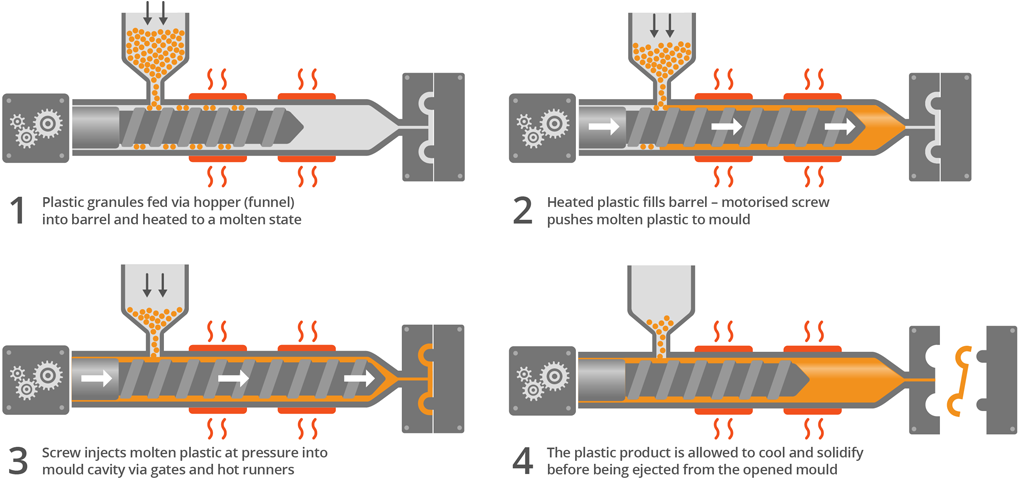Injection molding is a fascinating and complex process that is crucial in the manufacturing of countless everyday products. From automotive parts to household items, injection molding shapes our world in more ways than we might realize. Whether you're an industry professional looking to brush up on your knowledge or a curious individual wanting to learn more, this blog post will guide you through the five essential steps of injection molding.
Understanding these steps not only provides insight into this remarkable process but also highlights the precision and innovation behind the items we often take for granted. So, as a professional plastic injection molding manufacturer, I will dive in and explore the intricate world of injection molding!
Step 1: Clamping
The first step in the injection molding process is clamping. This is a crucial preparatory stage where the mold halves are securely closed and held together by the clamping unit. The clamping unit's primary function is to ensure that the mold remains closed and withstands the pressure from the injected material.
The Role of the Clamping Unit
The clamping unit is typically composed of three main parts: the mold, the clamping mechanism, and the injection unit. It is vital for maintaining the integrity of the mold during the injection process. Without proper clamping, the mold could open, leading to defects and potentially hazardous situations.
Types of Clamping Mechanisms
There are different types of clamping mechanisms used in injection molding:
- Toggle Clamps: These use a mechanical linkage to amplify the force applied.
- Hydraulic Clamps: These use hydraulic pressure to apply force.
- Electric Clamps: These use electric motors to generate the required force.
A well-maintained clamping unit ensures consistent product quality and operational safety. According to a study by Plastics Technology, well-calibrated clamping units can reduce defect rates by up to 15%.

Recommended Reading: What is the Process of Injection Molding
Step 2: Injection
Once the mold is securely clamped, the next step is injection. This involves feeding the raw plastic material into the injection molding machine, where it is heated until it becomes molten. The molten material is then injected into the mold cavity.
The Injection Unit
The injection unit consists of several components:
- Hopper: This is where the raw plastic material (usually in the form of pellets) is loaded.
- Barrel: This is where the material is heated and mixed.
- Screw: This component moves the molten material through the barrel and into the mold.
Injection Pressures and Speeds
The pressure and speed at which the material is injected are critical parameters. High pressure ensures that the material fills the mold cavity completely, while controlled speed prevents defects like air pockets or incomplete filling. Typical injection pressures range from 10,000 to 30,000 psi, depending on the material and part design.
Step 3: Dwelling
Dwelling, also known as packing, is the third step in the injection molding process. This phase ensures that the mold cavity is completely filled and that the molten material is evenly distributed.
Importance of Dwelling
During the dwelling phase, additional material is packed into the mold to compensate for material shrinkage as it cools. This is crucial for maintaining the dimensional accuracy and structural integrity of the final product.
Parameters to Monitor
Key parameters to monitor during the dwelling phase include:
- Pressure: Ensures even filling and compensates for shrinkage.
- Time: Duration of the dwelling phase, typically ranging from a few seconds to several minutes.
Studies show that improper dwelling settings can lead to a 20% increase in defective parts, emphasizing the importance of this step.
Step 4: Cooling
The cooling stage is where the molten plastic solidifies into the desired shape within the mold. This is often the longest phase in the injection molding process, but it's crucial for determining the final properties of the product.
Cooling Time
Cooling time depends on several factors, including the material type, part geometry, and mold temperature. On average, cooling can take anywhere from a few seconds to several minutes. Efficient cooling systems are essential for reducing cycle times and improving productivity.
Cooling Techniques
Various cooling techniques are employed to expedite this phase:
- Conformal Cooling: Uses channels that follow the contour of the mold, providing uniform cooling.
- Baffles and Bubbler Tubes: Direct cooling fluids to specific areas within the mold.
A report from MoldMaking Technology indicates that advanced cooling techniques can reduce cooling times by up to 30%, significantly enhancing overall efficiency.
Step 5: Ejection
The final step in the injection molding process is ejection. Once the plastic part has cooled and solidified, it must be removed from the mold. This step involves the use of an ejection system to push the part out of the mold cavity.
The Ejection System
The ejection system typically consists of:
- Ejector Pins: These push the part out of the mold.
- Ejector Plates: These are used to support and guide the ejector pins.
- Air Blasts and Strippers: These assist in the removal of the part from the mold.
Post-Ejection Considerations
After ejection, parts often undergo additional processes such as trimming, inspection, and packaging. Ensuring a smooth ejection process minimizes the risk of damage to the parts, maintaining their quality.
Conclusion
Injection molding is a multi-faceted process that involves precision, control, and expertise. By understanding the five essential steps—clamping, injection, dwelling, cooling, and ejection—you gain insight into the complexities and innovations that drive this industry.
From the initial clamping of the mold to the final ejection of the product, each stage plays a critical role in ensuring the quality and functionality of the final item. Whether you're involved in manufacturing or simply curious about how things are made, this knowledge offers a deeper appreciation for the technology and skill that bring everyday objects to life. Start preparing to share your requirements with BaiweMolding, where we bring your ideas to life with exceptional injection molding services!

